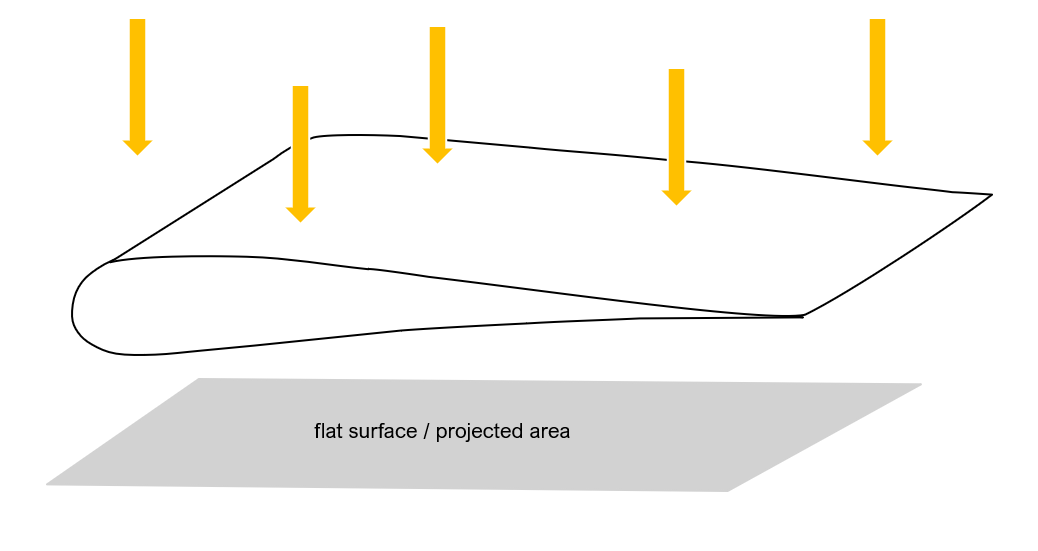Most of us do their first foiling attempts by attending a training course or using a friend’s foil. At that time, most of us do not ask too many questions about the design of the front- or rear wing and also do not question, why there are so many different shapes.
However, once you start to look more into different foils, you will discover, that there are many different shapes and sizes. Visiting some online shops or websites of foil producers, you will find information about different dimensions describing the foil. But what do those dimensions stand for and how do you interpret them? Let us have a look at some of the dimensions you will usually find when comparing different foils.
Area of the wing
The area of the wing is a first indicator if a wing will create more or less lift force. Looking into the formula to calculate the lift force, we know that the lift force is dependent on the area of the wing (check out our article about physics of a hydrofoil). In case all other parameters stay the same, you can conclude that a wing with a bigger area will in general create more lift than a wing with a smaller area. However, looking at different brands and products, you will recognize that some of them indicate the „full surface“ or „actual area“ and others the „flat surface“ or „projected area“ of the wing. Some of them will also provide both dimensions. But what is the difference?
Surface Area / Actual Area
Most of the wings are not flat but follow a curve – means the surface is not flat. The surface area of a solid object is a measure of the total area that the surface of the object occupies [1]. The surface area of a wing is usually the surface of the upper skin of the wing.


fig. Surface Area resp. Actual Area of a Wing
Flat Surface / Projected Area
The projected area is the flat area of a three-dimensional object when you project it on a flat surface. When you put a light straight over a wing, you will see a shadow which is the projected area.

fig. Flat Surface resp. Projected Area
Knowing now what the different surfaces describe, how can we interpret the difference between the surface and the projected area?
Basically, the bigger the difference between the surface area and the projected area, the bigger is the curve of the wing – and with that in most of the cases also the lift.
Aspect Ratio
Describing a wing, most makers also provide you the so called aspect ratio. Thereby, the aspect ratio is the ratio between the wingspan and the chord length of the wing. The wing span is pretty much self-explaining. But what is the chord length? The chord length is the distance between the leading edge and trailing edge of the wing.

fig. Chord Lenght of a Wing
Unless you use a rectangular wing, the chord length will not be equal along the length of the span and therefore, the aspect ratio is usually calculated by dividing the square of the wingspan by the reference wing area.

Low aspect ratio wings are short and fat, while high aspect ratio wings are long and thin.


Low aspect wings in general accelerate quickly but have limited speed range. Due to their narrow wingspan, they tend to roll and have less glide which negatively impacts the pumping effect.
On the other hand, high aspect wings accelerate slower but have a greater speed range compared to the low aspect wings and in addition to that a better glide. Looking from the pumpfoilers perspective (or a wingfoiler that does some pumps during the takeoff phase), there is another advantage of high aspects wings. Due to the narrower chord of a high aspect wing compared to a low aspect wing, the drag is less when changing the angle of the front wing while pumping. Therefore, high aspect wings are generally preferred for pumpfoiling.
Profile / Thickness
When discussing the surface and projected area, we already found out, that wings with a bigger difference between the actual surface and projected surface have a bigger curve. However, we have not yet looked into the thickness of the wing and what general statements can be made about that.

In general, you can say that wings with a thicker profile create more lift to a similar wing which is thinner. However, the increased lift is coming with increased drag. Therefore, if you are looking for a wing that creates good lift at lower speeds, go for a thicker wing. It will help you to get flying quicker and is also more stable against changes in the angle of attack.
If you are looking for a faster wing, choose a wing with less thickness. Due to less drag, you can foil it at higher speeds, however this comes at the cost of less lift at lower speeds and it will be more sensitive to changes in the angle of attack.
Backwing / Stabilizer and Fuselage
The dimensions we looked at can actually be used to describe any wing. Therefore, not only the main or frontwing, but also the backwing of a foil setup. However, the task of the backwing is slightly different than the task of the frontwing.
Besides „backwing“ you will also read about „stabilizer“. The name stabilizer is derived of the backwings function. Whereas the frontwing’s main task is to create the lift, the task of the backwing is to stabilize the system. In fact, you can foil even without a backwing. If you have never done it, try it ![]() You will find out pretty quick, that the system is very wobbly.
You will find out pretty quick, that the system is very wobbly.
The backwing is giving horizontal stability to the system. A bigger backwing is providing more stability whereas a smaller backwing will make the system more agile.
When looking at the backwing, you should always look at it in combination with the fuselage and the position of the backwing on the fuselage. Many makers offer fuselages in different lengths and some also allow to attach the backwing at different positions. Similar to the size of the backwing, you can also conclude here: The shorter the fuselage (the closer the backwing is to the frontwing) the more agile and less stable is the foil.
Summary
The main dimensions describing a foil are the area, thickness and aspect ratio of the wing.
There are some rule of thumbs you can follow:
- The larger and thicker a wing is, the more lift it will create
- A thicker wing will create more lift, but also more drag and with that be slower than a less thick wing
- The longer the chord length, the more stability a wing will have
- High aspect ratio wings are long with a shorter chord, low aspect wings are short with a longer chord
- The smaller the backwing the more agile the system will be (less stable)
- The shorter the distance between the front- and backwing, the more gile the system will be (less stable)

